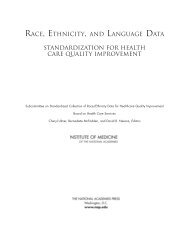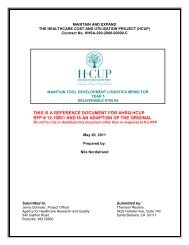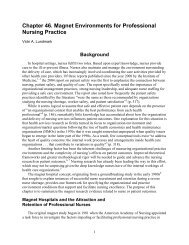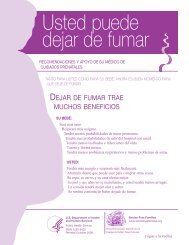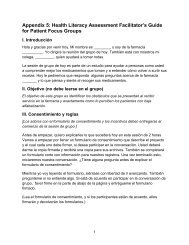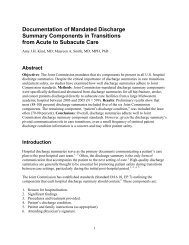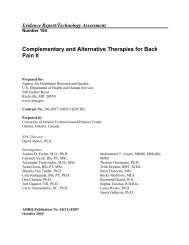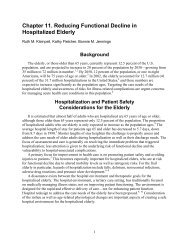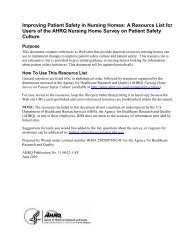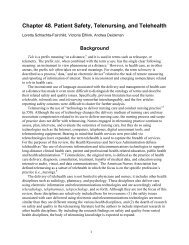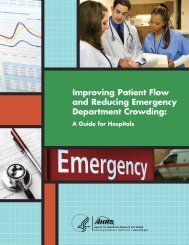Stories of Success: Using CUSP To Improve Safety - Agency for ...
Stories of Success: Using CUSP To Improve Safety - Agency for ...
Stories of Success: Using CUSP To Improve Safety - Agency for ...
You also want an ePaper? Increase the reach of your titles
YUMPU automatically turns print PDFs into web optimized ePapers that Google loves.
Saul advocated <strong>for</strong> the CLABSI bundle to be adopted by any clinician who placed lines whether<br />
at the bedside, in surgery, in the ER, or in a radiology suite. He encountered both resistance and<br />
support among physicians. He found a champion in Morris who, <strong>for</strong> the past ten years, had<br />
combined his practice with quality improvement (QI) work at the hospital, most recently<br />
becoming a full-time quality consultant with the hospital. As the PICC team gradually did more<br />
and more <strong>of</strong> the insertions and physicians did fewer, physician involvement in insertion lessened<br />
while acceptance <strong>of</strong> the PICC team expanded.<br />
CLABSI Team<br />
In 2009, the Joint Commission established a national patient safety goal <strong>of</strong> preventing CLABSI.<br />
Barbara Stehling, now Director <strong>of</strong> Quality Services, took it to the PICC team <strong>for</strong> evaluation and<br />
to assess what else Peterson needed to do. “Our practice was already pretty much in place, but<br />
we needed to be tracking and documenting it.” A CLABSI team was <strong>for</strong>med. Members included<br />
Saul, an ICU nurse, the Director <strong>of</strong> Quality Services, and a quality analyst.<br />
“CLABSI made the most sense,” Murray agreed. “We had a reasonably good track record, but<br />
could we still enhance or improve? Were our systems consistent with best practices? How could<br />
we be more consistent with the protocols we already had? How could we further engage the<br />
physicians?”<br />
Peterson revised hospital policy and procedures in 2010 to standardize use <strong>of</strong> the central line<br />
insertion and maintenance bundles hospital-wide <strong>for</strong> any clinician inserting any venous access<br />
device. Because the PICC Team was already operating throughout the hospital, these policy and<br />
procedural changes did not represent a dramatic change, but gave a significant boost to its housewide<br />
deployment.<br />
Standard, in fact, meant mandatory <strong>for</strong> nurses because they were employees, whereas physicians<br />
were independent practitioners. “A couple <strong>of</strong> whom,” Morris said, “were tough to get on board.”<br />
Peterson has a history <strong>of</strong> “doing everything jointly. Nursing may initiate something, and the<br />
physician committees bless or fine tune it.” However, as he pointed out, “We don’t pay them, we<br />
only give them privileges. We are a small town with a shortage <strong>of</strong> doctors. We do keep track <strong>of</strong><br />
things, and if they have enough variation in outcomes, recredentialing is not automatic.” Sooner<br />
or later, resistors came around through peer pressure and one-on-one conversations with Morris.<br />
Morris’s indirect style <strong>of</strong> engaging physicians and sense <strong>of</strong> timing did not press or initiate discussion<br />
directly. Instead, during the course <strong>of</strong> a conversation, perhaps over lunch, he might bring out<br />
an article to share, “I wonder if you would like to read it,” or, “See what you think.” Morris was<br />
keenly aware that,<br />
“Physicians resist being told what to do by quality people, the government, or core<br />
measures—especially if it’s different from what they’ve been taught, but they are still<br />
scientists. I point out that they were also told in medical school, and this is what new<br />
physicians are being told. If they want to keep up, they might want to take a look.”<br />
Once Peterson “hardwired” the CLABSI bundle into practice and sustained a CLABSI rate <strong>of</strong><br />
zero, it was no longer necessary <strong>for</strong> the CLABSI team to meet regularly. Peterson sustained zero<br />
through the skills <strong>of</strong> the Vascular Access Team, adherence to the insertion and maintenance<br />
8



